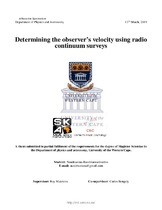| dc.contributor.advisor | Maartens, Roy | |
| dc.contributor.advisor | Bengaly, Carlos | |
| dc.contributor.author | Randriamiarinarivo, Nandrianina | |
| dc.date.accessioned | 2019-05-09T12:08:32Z | |
| dc.date.available | 2019-05-09T12:08:32Z | |
| dc.date.issued | 2019 | |
| dc.identifier.uri | http://hdl.handle.net/11394/6774 | |
| dc.description | >Magister Scientiae - MSc | en_US |
| dc.description.abstract | In the standard (‘concordance’) model of Cosmology, there is a fundamental assumption that the Universe is statistically isotropic and homogeneous on large scales, known as the Cosmological Principle. The Cosmological Principle requires that the dipole anisotropy apparent in the CMB should also be observed in galaxy number counts if this signal occurs due to the aberration and Doppler effects from our peculiar motion. This thesis will investigate the accuracy with which the cosmic kinematic dipole can be determined
by comparing real data from NRAO VLA Sky Survey (NVSS) catalog with the simulated sky maps following its specifications. The mock maps are generated using FLASK code which assumes a lognormal distribution for the radio count density field from z=0 to z =4 and taking as an entry an angular power spectrum from CAMB which assumed a flat ΛCDM cosmology and a redshift distribution. After analising the kinematic dipole, we turn to the analysis of statistical isotropy in the catalog. We used ANalysis Of Variance (ANOVA) test on patches in the sky of different radii as one of the statistical tools for the analysis.
We found that as we go to a higher radius for the patches, we have a better agreement between the theory and the observation as expected. We also saw that the more we are rigorous on the rejection criteria, the smaller is the discrepancy between the observed and simulated number count distribution in the sky. We found an optimum choice of 25◦ as patch size, and if the accepted patches have a maximum of 30% of their pixels masked.
Therefore, we find that the NVSS data agrees with the fundamental assumption of statistical isotropy at angular scales > 20◦. | en_US |
| dc.language.iso | en | en_US |
| dc.publisher | University of the Western Cape | en_US |
| dc.subject | Observer's velocity | en_US |
| dc.subject | Radio continuum surveys | en_US |
| dc.subject | Cosmological Principle | en_US |
| dc.subject | NRAO VLA Sky Survey (NVSS) | en_US |
| dc.subject | Cosmic kinematic dipole | en_US |
| dc.title | Determining the observer’s velocity using radio continuum surveys | en_US |
| dc.rights.holder | University of the Western Cape | en_US |

